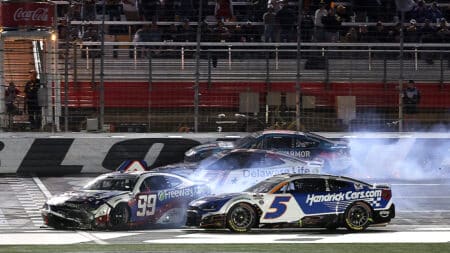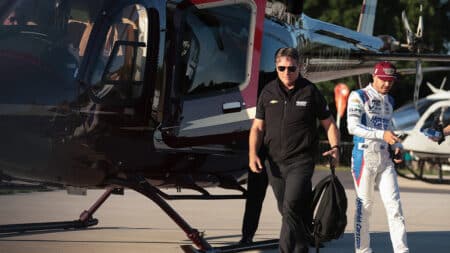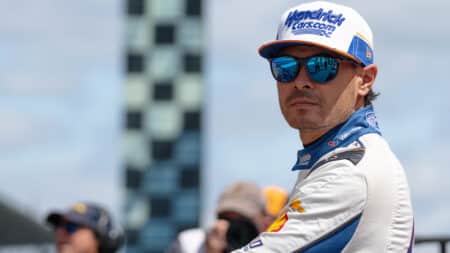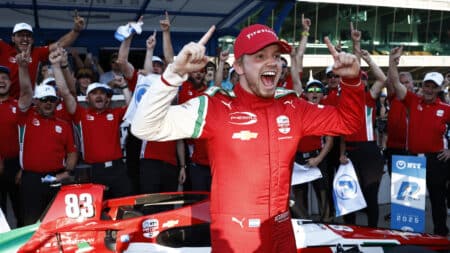
'Double isn't worth it', says Larson after 2025 attempt ends in disaster
Two crashes left Kyle Larson's hopes of completing the Indy 500 and Coca Cola 600 double in tatters — but did he even stand a chance in the first place?
Jim McGee is one of the most successful crew chiefs in the century-old history of Indycar racing. At Indianapolis last month I had the pleasure of joining him to launch my latest book, Jim McGee: Crew Chief of Champions. Thanks to my publisher Racemaker Press we enjoyed a fine launch at the Indianapolis Motor Speedway’s museum on the Friday evening before this year’s 98th running of the Indy 500. Jim and I signed many books for a great assembly of friends and fans followed by another signing the following day at the Speedway’s memorabilia show.
This week, I’ve extracted some pieces from chapter six of the book about Emerson Fittipaldi’s five years with Patrick Racing from 1985-89. McGee ran Patrick Racing through this time and in 1989 Fittipaldi won both the Indy 500 and the CART championship.
A two-time F1 World Champion in 1972 and ’74, Fittipaldi retired from F1 in 1980 but decided three years later to make a comeback in America racing Indycars. He started his Indycar career at the Portland road course in June of ‘84 driving a year-old March owned by a dubious fellow named Pepe Romero and ran a handful of races over the summer for a couple of small teams.

Pocono, 1985
When the door opened to Fittipaldi at Patrick Racing the great Brazilian immediately showed his stuff, finishing fourth at Mid-Ohio in 1984. In 1985 Fittipaldi drove full-time for Patrick. He finished second at Long Beach, led some laps at Indianapolis and scored his first Indycar victory in July’s Michigan 500, beating Al Unser Sr across the line.
“Emerson was great,” McGee remarks. “He was real cool and he did a good job. He knew how to finish races and he knew on the ovals you just couldn’t make mistakes. Emerson was the first guy I worked with who really focused on the seat. He was very complimentary about our seat. We spent a lot of time working on the seat and Emerson said when he had a good seat he could concentrate on the feel of the car and not have to brace himself and hold himself in place. He said he could concentrate on the corner and what he was going to have to do.
“Pat [Patrick] used to complain about the money we spent on seats. We used to spend $30,000-$40,000 by the time we got a good seat. We would do two or three moulds and work carefully on all the details to get the seat right for each driver. It was a very extensive process but to me it was a big performance gain and Emerson agreed.”

Indy 500 wins
1969 (Mario Andretti)
1979 (Rick Mears)
1982 (Gordon Johncock)
1989 (Emerson Fittipaldi)
Championships
1965, ’66 & ’69 (Mario Andretti)
1977 & ’78 (Tom Sneva)
1979 (Rick Mears)
1989 (Emerson Fittipaldi)
1992 (Bobby Rahal)
1993 (Nigel Mansell)
When Fittipaldi won his second world championship in 1974 with McLaren, he was sponsored by Marlboro and at the end of 1985 the tobacco giant decided it was going to expand into Indycar racing. Fittipaldi had maintained good relations with Marlboro and its parent company, Philip Morris, and the Brazilian was Marlboro’s choice to be their Indycar driver starting in 1986.
Fittipaldi was on the pole for the CART races at Portland and Toronto in 1986 and scored his first win for Marlboro in a rain-delayed race at Elkhart Lake in September. The following year he won a pair of back-to-back midsummer races in Cleveland and Toronto. Emerson started the 1988 season driving a March-Chevrolet but switched in the middle of the season to a 1987 Lola-Chevy.
“Emerson crashed the March at Indianapolis on Carburetion Day,” McGee recalls. “He went against his principles that day. He had a saying about the ovals, especially Indianapolis, that you couldn’t make a mistake, and on Carburetion Day in 1988 he didn’t like the car. It wasn’t very fast and didn’t feel good and he over-drove the car. After the crash he said, ‘I made a big mistake. I went against my principles that you just can’t make a mistake on an oval. If you do, you will pay for it, and I did today.’

“He wasn’t very happy with the March so after Indy we bought a previous year’s Lola from Carl Haas. Tyler Alexander was Newman/Haas’s crew chief at the time and he didn’t know Carl had sold the car to us, and when he learned about it he was really unhappy because the ‘88 Lola wasn’t as good as the ‘87 Lola and they had to run the ’88 car. Tyler really chewed Carl’s ass about selling us that car. We won Mid-Ohio and Elkhart Lake with the ‘87 Lola and Emerson loved that car. He named it Lolita.”
For 1989 an agreement was hatched between Fittipaldi, Patrick, Marlboro and Roger Penske for Emerson to race the latest Penske PC18 and Fittipaldi came through with flying colours to win both the Indy 500 and CART championship with a total of five race wins and four poles.
“In ‘89 we got the Penskes,” McGee relates. “That was a funny deal because Roger had Miller High Life as a sponsor and we had Marlboro. So Roger made a deal with Emerson in 1988 that he would sell Patrick cars for ‘89 and then Emerson would come to Penske in 1990 and bring the Marlboro sponsorship with him.
“Morris Nunn worked for us in 1988 and ‘89. He was the engineer and he did a good job. The deal in ’89 was Roger would sell us the cars and give us all of the updates until Indy and then after Indy we were on our own.”

Fittipaldi won the Indy 500 in ’89 after a classic battle with Al Unser Jr wherein Unser finished the race in the wall. “Emerson was very calculating,” McGee remarks. “He’s cunning in a lot of ways and very charming. Look at the way he handled it at Indy when he put Al Jr in the fence. Anybody else would have had a huge controversy on their hands, but Emerson handled it with cunning and charm. It was also because Al Jr respected Emerson and the credentials he had as a Formula 1 World Champion. Instead of complaining and giving Emerson the finger Al gave him the thumbs up. It was great for Emerson and great for Little Al who looked like a hero.”
In June and July Fittipaldi won three more races in a row in Detroit, Portland and Cleveland and added another win at Nazareth near the end of the year. “We had a good combination going and I think it upset and agitated Roger,” Jim says. “He was all over his guys complaining that they couldn’t beat us even though they had new stuff for the car and we didn’t. After Indy we didn’t get any more developments or parts from Penske. We did a few of our own little modifications but Roger’s guys wouldn’t even talk to us about the car.

Indy with Penske, 1991
“But we beat Roger pretty bad that year and won the championship as well as the Indy 500. One of the last races was at Nazareth and Ellen Merlo was a big wheel at Philip Morris. She came to me and said we were doing a great job. ‘But we don’t care,’ she said, ‘if you win any more races this year.’ She was getting a lot of heat from her people asking why Emerson was going to Penske when Patrick was beating them. It was funny.”
Comments Fittipaldi: “I liked very much working with Jim. I felt very comfortable and very at home with him. Jim knew a lot about racing and he knew how to handle the driver and the team. He was always very sensitive to any of the difficulties that can occur between people who are working together in a very demanding situation. Jim is a racer through and through who understands all the aspects of racing and it’s very rare to find a man with all those qualities.
“I learned a lot from Jim and all the experience he had at Indianapolis. I think there were two key moments in my career. When I joined Lotus and Colin Chapman in Formula 1 it was great for me, and then when I signed with Patrick Racing in Indycars I was learning very fast in both situations from people who had so much experience. Those two periods in my career taught me so much. With Patrick Racing and Jim McGee I learned so much about oval racing just like I had learned so much about Formula 1 and road circuit racing with Colin and Lotus.

“Jim was always very detailed in explaining how things worked on ovals. The oval tracks required a completely new technique for me to learn, not just driving the car but setting up the car. Jim was one of the best teachers I could have had just as Colin Chapman was. I was very lucky to have two men with so much experience and expertise to learn from.”
Fittipaldi and Marlboro went off together to Penske’s team in 1990 and Emerson won the 500 again in 1993 before retiring after a terrible, life-threatening crash on the opening lap of the 1996 Michigan 500.
For his part, McGee continued with Patrick for a few more years before directing Bobby Rahal’s new team to win CART’s 1992 championship, then joining Newman/Haas for two years to manage Nigel Mansell and Mario Andretti as reluctant teammates. McGee’s ninth and last Indycar championship came with Mansell in ’93 before he rejoined Pat Patrick’s team at the end of 1994.

McGee ran Patrick’s team through 2003, then spent a few years with PKV Racing before retiring at the end of 2006, although Chip Ganassi invited McGee back into action at Indianapolis this year to call the race day strategy for Ryan Briscoe’s car. Jim enjoyed himself and is flying in to call the shots on Briscoe’s car at this year’s remaining IndyCar races.
Jim McGee: Crew Chief of Champions is a handsome 11×11 inch, hard-backed book comprising 290 pages with more than 300 photographs plus statistics of McGee’s wins, drivers and teams. The book is available from Racemaker Press for US$74.95 plus shipping and handling. To order, please click on the cover below.

Two crashes left Kyle Larson's hopes of completing the Indy 500 and Coca Cola 600 double in tatters — but did he even stand a chance in the first place?

The crunch point of Kyle Larson's Indy 500 and Coca Cola 600 double bid will come as he races from Indianapolis to Charlotte in a complex procedure involving cars, helicopters and planes. Ryan Glenn will be co-ordinating it... by text message

Kyle Larson will once again attempt the double this weekend. He explains his plans to complete the Indy 500 and NASCAR's Coca-Cola 600 in one day and overcome the "PTSD" of last year's bid

Robert Shwartzman and Prema stunned the field by claiming pole position for the 2025 Indianapolis 500 in his first-ever oval race. Here's a look at how they pulled it off